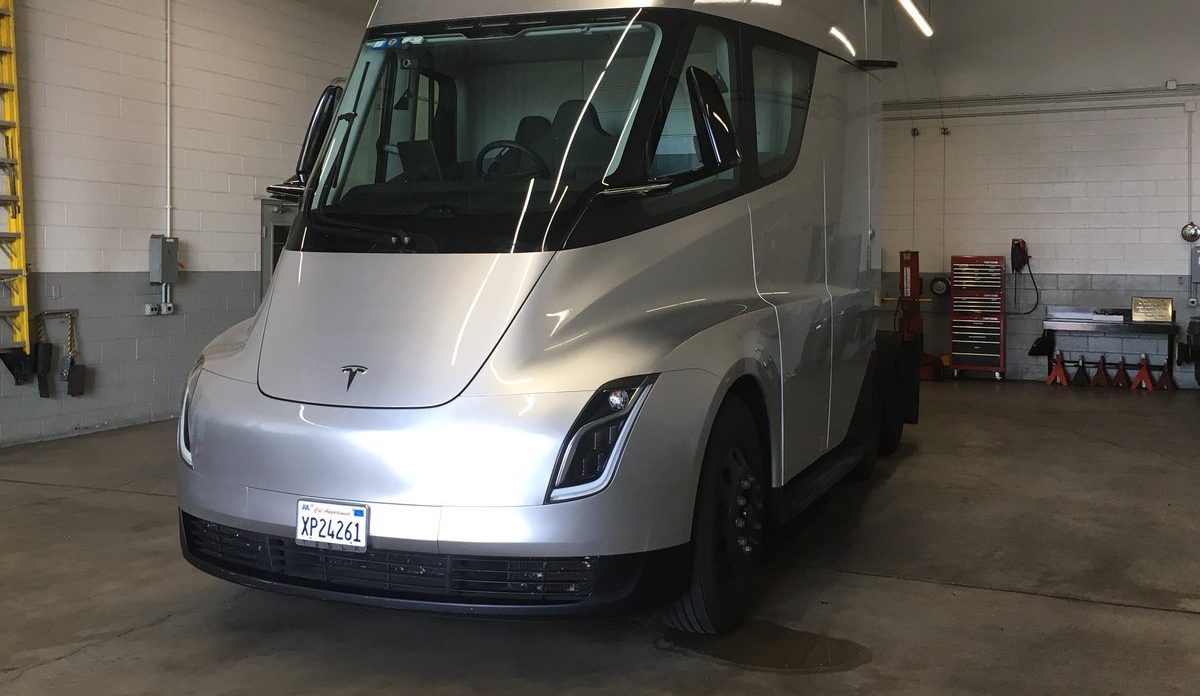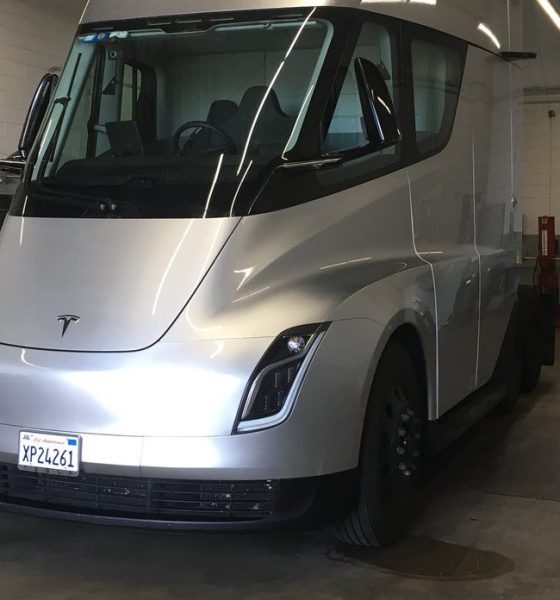

News
Tesla Semi reservation holders are remaining unfazed amid skepticism, rising competition
While there remains a notable amount of skepticism from legacy trucking companies, the emergence of zero-emissions semi-trailers is looking more and more inevitable. Among these vehicles is the Tesla Semi, a battery-powered all-electric vehicle aimed at disrupting the lucrative trucking market.
Tesla pulled no punches with the Semi, with the Class 8 truck being capable of traveling up to 500 miles with one charge. In true Tesla tradition, the Tesla Semi is also very quick, thanks to its four Model 3-derived electric motors whose instant torque allows it to accelerate from 0-60 mph in 5 seconds flat without a trailer. That’s muscle car-level acceleration — from a large, fully capable electric long-hauler.
When Elon Musk announced the Semi last year, he noted that the vehicle is expected to start production sometime in 2019. Such a timeline is an aggressive goal for the company, considering that Tesla is yet to announce where the large electric truck would be built. Considering Elon Musk’s tendency to be overly optimistic about his targets, as well as Tesla head of investor relations Martin Viecha’s statement earlier this year when he noted that the company is “earnestly” planning on producing the Semi by 2020, skeptics of the company suggest that the all-electric truck would likely see notable manufacturing delays, just like the Model 3 and Model X.
Despite these reservations, Tesla Semi reservation holders appear to be fully confident in the company’s capability to deliver the vehicle. In a statement last month, NFI Industries vice president of fleet services James O’Leary, whose company ordered 10 Semis, stated that the electric car maker is actually staying relatively consistent with its self-imposed timeline.
“They are staying relatively consistent with their timeline, even though Elon doesn’t talk about it on their earnings call,” he said.
Albertsons Companies, one of the United States’ largest food and drug retailers, revealed its order of 10 Tesla Semis earlier this month. In a press release, the company noted that its adoption of the Semi is part of its efforts to decrease its overall carbon emissions and run a cleaner fleet. Tom Nartker, VP of Transportation, stated that Tesla Semi would play a part in advancing the company’s supply chain efficiency and sustainability as well.
“Advancing supply chain efficiency and sustainability is an important goal for our company. We’re excited to pilot this expansion of our transportation program with trucks that help us limit our overall carbon footprint,” Nartker said.
Much like the passenger car market, the emergence of electric-powered vehicles is starting to become notable in the trucking industry. Legacy automaker Daimler, for one, has released vehicles like an electrified Freightliner as an alternative to fossil fuel-powered trucks. Hydrogen-electric vehicles from startups like Nikola Motor are also expected to enter the market in the coming years. Amidst these competitors, the Tesla Semi could very well play a large part in the emerging zero-emissions trucking market, as it aims to prove that battery-powered long-haulers are fully-capable of performing tasks usually reserved for diesel trucks.
The market for the Tesla Semi is vast, and so far, reactions from the market have been encouraging. As of the company’s Q1 2018 earnings call, CEO Elon Musk and CTO JB Straubel noted that Tesla had around 2,000 reservations for the vehicle, from companies such as PepsiCo, FedEx, and UPS in the United States and Bee’ah from the United Arab Emirates, to name a few. Overall, Tesla appears to have targeted the perfect market that is ready to be disrupted with the Semi — and it is a market that is prepared to invest and wait for a vehicle that would satisfy its needs.

Elon Musk
Elon Musk’s X will start using a Tesla-like software update strategy
The initiative seems designed to accelerate updates to the social media platform, while maintaining maximum transparency.

Elon Musk’s social media platform X will adopt a Tesla-esque approach to software updates for its algorithm.
The initiative seems designed to accelerate updates to the social media platform, while maintaining maximum transparency.
X’s updates to its updates
As per Musk in a post on X, the social media company will be making a new algorithm to determine what organic and advertising posts are recommended to users. These updates would then be repeated every four weeks.
“We will make the new 𝕏 algorithm, including all code used to determine what organic and advertising posts are recommended to users, open source in 7 days. This will be repeated every 4 weeks, with comprehensive developer notes, to help you understand what changed,” Musk wrote in his post.
The initiative somewhat mirrors Tesla’s over-the-air update model, where vehicle software is regularly refined and pushed to users with detailed release notes. This should allow users to better understand the details of X’s every update and foster a healthy feedback loop for the social media platform.
xAI and X
X, formerly Twitter, has been acquired by Elon Musk’s artificial intelligence startup, xAI last year. Since then, xAI has seen a rapid rise in valuation. Following the company’s the company’s upsized $20 billion Series E funding round, estimates now suggest that xAI is worth tens about $230 to $235 billion. That’s several times larger than Tesla when Elon Musk received his controversial 2018 CEO Performance Award.
As per xAI, the Series E funding round attracted a diverse group of investors, including Valor Equity Partners, Stepstone Group, Fidelity Management & Research Company, Qatar Investment Authority, MGX, and Baron Capital Group, among others. Strategic partners NVIDIA and Cisco Investments also continued support for building the world’s largest GPU clusters.
News
Tesla FSD Supervised wins MotorTrend’s Best Driver Assistance Award
The decision marks a notable reversal for the publication from prior years, with judges citing major real-world improvements that pushed Tesla’s latest FSD software ahead of every competing ADAS system.

Tesla’s Full Self-Driving (Supervised) system has been named the best driver-assistance technology on the market, earning top honors at the 2026 MotorTrend Best Tech Awards.
The decision marks a notable reversal for the publication from prior years, with judges citing major real-world improvements that pushed Tesla’s latest FSD software ahead of every competing ADAS system. And it wasn’t even close.
MotorTrend reverses course
MotorTrend awarded Tesla FSD (Supervised) its 2026 Best Tech Driver Assistance title after extensive testing of the latest v14 software. The publication acknowledged that it had previously criticized earlier versions of FSD for erratic behavior and near-miss incidents, ultimately favoring rivals such as GM’s Super Cruise in earlier evaluations.
According to MotorTrend, the newest iteration of FSD resolved many of those shortcomings. Testers said v14 showed far smoother behavior in complex urban scenarios, including unprotected left turns, traffic circles, emergency vehicles, and dense city streets. While the system still requires constant driver supervision, judges concluded that no other advanced driver-assistance system currently matches its breadth of capability.
Unlike rival systems that rely on combinations of cameras, radar, lidar, and mapped highways, Tesla’s FSD operates using a camera-only approach and is capable of driving on city streets, rural roads, and freeways. MotorTrend stated that pure utility, the ability to handle nearly all road types, ultimately separated FSD from competitors like Ford BlueCruise, GM Super Cruise, and BMW’s Highway Assistant.
High cost and high capability
MotorTrend also addressed FSD’s pricing, which remains significantly higher than rival systems. Tesla currently charges $8,000 for a one-time purchase or $99 per month for a subscription, compared with far lower upfront and subscription costs from other automakers. The publication noted that the premium is justified given FSD’s unmatched scope and continuous software evolution.
Safety remained a central focus of the evaluation. While testers reported collision-free operation over thousands of miles, they noted ongoing concerns around FSD’s configurable driving modes, including options that allow aggressive driving and speeds beyond posted limits. MotorTrend emphasized that, like all Level 2 systems, FSD still depends on a fully attentive human driver at all times.
Despite those caveats, the publication concluded that Tesla’s rapid software progress fundamentally reshaped the competitive landscape. For drivers seeking the most capable hands-on driver-assistance system available today, MotorTrend concluded Tesla FSD (Supervised) now stands alone at the top.
News
Elon Musk’s Grokipedia surges to 5.6M articles, almost 79% of English Wikipedia
The explosive growth marks a major milestone for the AI-powered online encyclopedia, which was launched by Elon Musk’s xAI just months ago.

Elon Musk’s Grokipedia has grown to an impressive 5,615,201 articles as of today, closing in on 79% of the English Wikipedia’s current total of 7,119,376 articles.
The explosive growth marks a major milestone for the AI-powered online encyclopedia, which was launched by Elon Musk’s xAI just months ago. Needless to say, it would only be a matter of time before Grokipedia exceeds English Wikipedia in sheer volume.
Grokipedia’s rapid growth
xAI’s vision for Grokipedia emphasizes neutrality, while Grok’s reasoning capabilities allow for fast drafting and fact-checking. When Elon Musk announced the initiative in late September 2025, he noted that Grokipedia would be an improvement to Wikipedia because it would be designed to avoid bias.
At the time, Musk noted that Grokipedia “is a necessary step towards the xAI goal of understanding the Universe.”
Grokipedia was launched in late October, and while xAI was careful to list it only as Version 0.1 at the time, the online encyclopedia immediately earned praise. Wikipedia co-founder Larry Sanger highlighted the project’s innovative approach, noting how it leverages AI to fill knowledge gaps and enable rapid updates. Netizens also observed how Grokipedia tends to present articles in a more objective manner compared to Wikipedia, which is edited by humans.
Elon Musk’s ambitious plans
With 5,615,201 total articles, Grokipedia has now grown to almost 79% of English Wikipedia’s article base. This is incredibly quick, though Grokipedia remains text-only for now. xAI, for its part, has now updated the online encyclopedia’s iteration to v0.2.
Elon Musk has shared bold ideas for Grokipedia, including sending a record of the entire knowledge base to space as part of xAI’s mission to preserve and expand human understanding. At some point, Musk stated that Grokipedia will be renamed to Encyclopedia Galactica, and it will be sent to the cosmos.
“When Grokipedia is good enough (long way to go), we will change the name to Encyclopedia Galactica. It will be an open source distillation of all knowledge, including audio, images and video. Join xAI to help build the sci-fi version of the Library of Alexandria!” Musk wrote, adding in a later post that “Copies will be etched in stone and sent to the Moon, Mars and beyond. This time, it will not be lost.”








